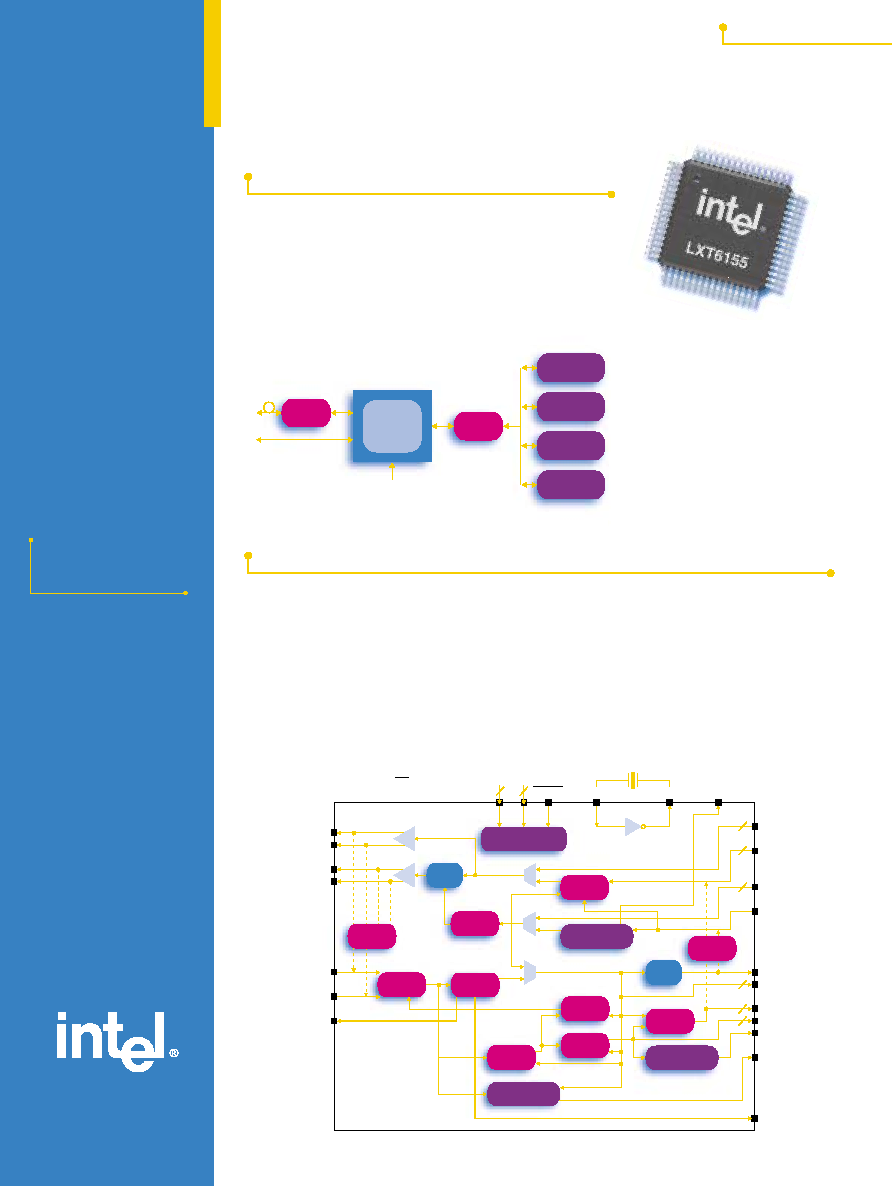
www.intel.com/
design/network
Intel
Æ
Internet Exchange
Architecture
The Intel
Æ
Advantage
Intel combines mixed-signal design expertise with proven CMOS technology to produce low-power, cost-
effective connectivity solutions. Intel's LXT6155 transceiver provides increased functionality and greater
reliability, two critical requirements for central office and digital loop carrier systems. With its outstanding
jitter performance, the Intel LXT6155 transceiver meets stringent SONET/SDH standards for system and
network reliability and serviceability.
By providing evaluation boards, a GUI interface, and additional design information, Intel offers excellent
customer support that helps reduce time to market. Combined with Intel's portfolio of LAN and WAN
products, the Intel LXT6155 transceiver provides a comprehensive client-to-client solution.
The diagram below outlines the major functional blocks in the Intel LXT6155 transceiver.
Product Description
The Intel
Æ
LXT6155 transceiver is a highly integrated, low-power
Synchronous Optical Network (SONET) and Synchronous Digital
Hierarchy (SDH) transceiver that supports fiber and coax trans-
mission on the same chip. OC3/STM1/STS3/STS3c-compatible
at 155Mbps, the Intel LXT6155 transceiver helps maximize
proven mixed-signal design expertise in 3.3V CMOS technology,
consuming 650mW of power and allowing the integration
of multiple OC3s on the same board.
Intel
Æ
LXT6155 Mbps Transceiver
product brief
T1/E1
Mapper
ATM
Layer device
DS3
Mapper
IP
Layer device
LXT6155
Clock and Data
Recovery
Fiber
Module
Coax-STS3/
STM1
Fiber-OC3
OHT
LXT6155 Block Diagram
TTIP1
TTIP0
TRING1
HWSEL
XTALIN
XTALOUT
TXISH
RRING
TRING0
RTIP
RXISH
TPOS, TNEG
TSICLKP,
TSICLKN
TPID<7:0>
RSOCLKP,
RSOCLKN
TPICLK
RPOCLK
RPOD<7:0>
RPOS, RNEG
ROFP/CMIERR
LOS
LOCK
Frequency
Doubler
CMI
Encode
Divide
8
Adaptive
Equalizer
CMI/NRZ
Decode
Parallel/
Serial
x8 Synthesizer
PLL
Control
Logic
Control
Registers
µ
P Control (CS, SCLK, SDI, SDO),
Hardware (MODE0, SP, CIS, RIFE)
Optional
19.4 MHz crystal
RLIS,
LLIS
2
8
2
2
8
4
2
2
Clock
Recovery
PPL
Equalizer
Control
Data
Recovery
Serial/
Parallel
Frame Detect
and Byte Aligner
Loss of Signal
(LOS)
Local
Loopback
Remote
Loopback
This diagram illustrates a typical application for Intel's LXT6155 transceiver.
The Intel LXT6155 transceiver is
designed to support high-bandwidth
Internet and eCommerce applications
in next generation network equipment
such as:
s
Digital Cross Connect Systems
(DCCS)
s
Digital Loop Carriers (DLC)
s
Add/Drop and Terminal Multiplexers
s
Digital Subscriber Loop Access
Multiplexers (DSLAM)
s
Asynchronous Transfer Mode (ATM)
Wide Area Network (WAN)
transmission systems

© 2000 Intel Corporation
Order Number: 248953-001 Printed in USA/1100/1K/MG/DC
UNITED STATES AND CANADA
Intel Corporation
Robert Noyce Bldg.
2200 Mission College Blvd.
P.O. Box 58119
Santa Clara, CA 95052-8119
USA
EUROPE
Intel Corporation (UK) Ltd.
Pipers Way
Swindon
Wiltshire SN3 1RJ
UK
ASIA-PACIFIC
Intel Semiconductor Ltd.
32/F Two Pacific Place
88 Queensway, Central
Hong Kong, SAR
JAPAN
Intel Kabushiki Kaisha
P.O. Box 115 Tsukuba-gakuen
5-6 Tokodai, Tsukuba-shi
Ibaraki-ken 305
Japan
SOUTH AMERICA
Intel Semicondutores do Brazil
Rue Florida, 1703-2 and CJ22
CEP 04565-001 Sao Paulo-SP
Brazil
Information in this document is provided in connection with Intel products. No license, express or implied, by estoppel or otherwise, to
any intellectual property rights is granted by this document. Except as provided in Intel's Terms and Conditions of Sale for such
products, Intel assumes no liability whatsoever, and Intel disclaims any express or implied warranty, relating to sale and/or use of Intel
products including liability or warranties relating to fitness for a particular purpose, merchantability, or infringement of any patent,
copyright, or other intellectual property right. Intel products are not intended for use in medical, life saving or life sustaining applications.
Intel may make changes to specifications and product descriptions at any time, without notice.
Designers must not rely on the absence or characteristics of any features or instructions marked "reserved" or "undefined."
Intel reserves these for future definition and shall have no responsibility whatsoever for conflicts or incompatibilities arising from future
changes to them.
* Other brand names are the property of their respective owners.
s
An inexpensive design technology used in integrated circuit
chip design that allows very low power consumption (less than
650mW is typical) for optimal board usage
s
Meets with Bellcore GR-253, ITU-T G.703/825/958 STM1
and ANSI specification requirements
s
Allows 155.52Mbps transmission over coax cable
s
Allows 155.52Mbps transmission over fiber and in TDM or
ATM networks
s
Generates alarm signal informing network operators of weak
or lost signals
s
No external circuitry needed
s
Offers high interoperability with numerous OHT devices
s
Operable with 3.3V modules
s
Compatible with standard Intel and Motorola* devices
s
Can operate in hardware stand-alone mode or software mode
(microprocessor-controlled)
s
Complementary Metal Oxide Semiconductor (CMOS)
s
Complies with Synchronous Optical Network (SONET)
and Synchronous Digital Hierarchy (SDH) specifications
s
Code Mark Inversion (CMI) Interface
s
OC3 and STS3/STM1 support
s
Loss of Signal (LOS) Generation
s
On-chip equalizer and synthesizer
s
Framer/byte alignment function
s
Low Voltage Pseudo Emitter Couple Logic (LV PECL)
interface
s
Microprocessor interface
s
Hardware and software modes
Features
Benefits
Intel Access
Developer's Site
http://developer.intel.com
Intel Internet Exchange Architecture Home Page
http://www.intel.com/IXA
Networking Components Home Page
http://developer.intel.com/design/network
Other Intel Support:
http://developer.intel.com/design/litcentr/
Intel Literature Center
(800) 548-4725 7 a.m. to 7 p.m. CST (U.S. and Canada)
International locations please contact your local sales office.
General Information Hotline
(800) 628-8686 or (916) 356-3104 5 a.m. to 5 p.m. PST
Key Applications
s
OC3/STM1 SONET/SDH
Cross Connects
s
OC3/STM1 SONET/SDH
Add/Drop Multiplexer
s
OC3/STS3/STM1
Short Haul Serial Links
s
OC3/STM1 ATM/WAN
Access Systems
s
OC3/STM1 SONET/SDH
Digital Loop Carriers
s
OC3/STS3/STM1 ATM/WAN
Transmission Systems
Support Collateral
s
LXT6155 Application Reference Guide
s
LXT6155 Datasheet
s
LDB6155 FAQ
s
LXT6155 Demo board and User Guide
Intel
Æ
Internet Exchange Architecture
Intel
Æ
Internet Exchange Architecture is an end-to-end family
of high-performance, flexible and scalable hardware and
software development building blocks designed to meet the
growing performance requirements of today's networks.
Based on programmable silicon and software building
blocks, Intel IXA solutions enable faster development,
more cost-effective deployment and future upgradability
of network and communications systems.

